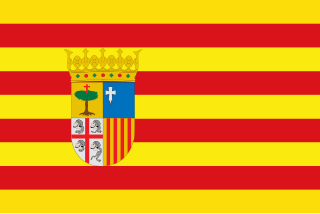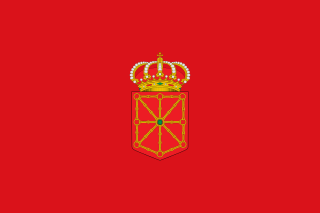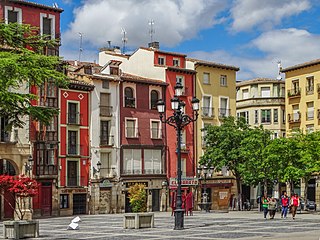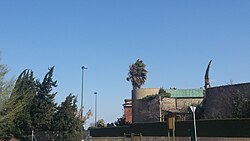
Aragon is an autonomous community in Spain, coextensive with the medieval Kingdom of Aragon. In northeastern Spain, the Aragonese autonomous community comprises three provinces : Huesca, Zaragoza, and Teruel. Its capital is Zaragoza. The current Statute of Autonomy declares Aragon a historic nationality of Spain.

Navarre, officially the Chartered Community of Navarre, is a landlocked foral autonomous community and province in northern Spain, bordering the Basque Autonomous Community, La Rioja, and Aragon in Spain and Nouvelle-Aquitaine in France. The capital city is Pamplona. The present-day province makes up the majority of the territory of the medieval Kingdom of Navarre, a long-standing Pyrenean kingdom that occupied lands on both sides of the western Pyrenees, with its northernmost part, Lower Navarre, located in the southwest corner of France.

The Royal Spanish Academy is Spain's official royal institution with a mission to ensure the stability of the Spanish language. It is based in Madrid, Spain, and is affiliated with national language academies in 22 other Hispanophone nations through the Association of Academies of the Spanish Language.

Zaragoza also known in English as Saragossa, is the capital city of the province of Zaragoza and of the autonomous community of Aragon, Spain. It lies by the Ebro river and its tributaries, the Huerva and the Gállego, roughly in the centre of both Aragon and the Ebro basin.

Logroño is the capital of the autonomous community of La Rioja, Spain. Located in the north of the Iberian Peninsula, primarily in the right (South) bank of the Ebro River, Logroño has historically been a place of passage, such as the Camino de Santiago. Its borders were disputed between the Iberian kingdoms of Castille, Navarre and Aragon during the Middle Ages.

El Hierro, nicknamed Isla del Meridiano, is the second-smallest and farthest south and west of the Canary Islands, in the Atlantic Ocean off the coast of Africa, with a population of 11,659 (2023). Its capital is Valverde. At 268.51 square kilometres (103.67 sq mi), it is the second-smallest of the eight main islands of the Canaries.

Almería is a city and municipality of Spain, located in Andalusia. It is the capital of the province of the same name. It lies in southeastern Iberia on the Mediterranean Sea. Caliph Abd al-Rahman III founded the city in 955. The city grew wealthy during the Islamic era, becoming a world city throughout the 11th and 12th centuries. It enjoyed an active port that traded silk, oil, and raisins. Being adjacent to a small desert, Almería has an exceptionally dry climate by European standards.

Montoro is a municipality of Spain belonging to the province of Córdoba, Andalusia. Housing lies on a bend of the river Guadalquivir, which envelopes from West, North, and East.

The Diccionario de la lengua española is the authoritative dictionary of the Spanish language. It is produced, edited and published by the Royal Spanish Academy, with the participation of the Association of Academies of the Spanish Language. It was first published in 1780, as the Diccionario de la lengua castellana and subsequent editions have been published about once a decade. The twenty-third edition was published in 2014; it is available on-line, incorporating modifications to be included in the twenty-fourth print edition.

The Autovía A-23 is a motorway in Aragon, Spain.

Quinto is a town and municipality in the province of Zaragoza, northeast Spain. It is located on the south bank of the river Ebro about 41 km south-east of Zaragoza, capital city of Aragon. In 2017 its population was 1,960, with an area of 118.40 km². Quinto is the capital of the comarca (county) of Ribera Baja del Ebro.

Navarro-Aragonese was a Romance language once spoken in a large part of the Ebro River basin, south of the middle Pyrenees; the dialects of the modern Aragonese language, spoken in a small portion of that territory, can be seen as its last remaining forms. The areas where Navarro-Aragonese was spoken might have included most of Aragon, southern Navarre, and La Rioja. It was also spoken across several towns of central Navarre in a multilingual environment with Occitan, where Basque was the native language.

The climate of Spain is highly diverse and varies considerably across the country's various regions. Spain is the most climatically diverse country in Europe with 13 different Köppen climates.
Madrid and its metropolitan area has a cold semi-arid climate which transitions to a mediterranean climate (Csa) on the western half of the city. According to the Troll-Paffen climate classification, Madrid has warm-temperate subtropical climate and according to the Siegmund/Frankenberg climate classification, Madrid has a subtropical climate. Madrid has hot summers and relatively cool winters with somewhat frequent frosts and occasional snowfalls, with 3-4 snowy days on average.
The 25th Division was one of the divisions of the Spanish Republican Army that were organized during the Spanish Civil War on the basis of the Mixed Brigades. It participated in the battles of Huesca, Belchite, Teruel and Levante.
The XII Army Corps was a military formation belonging to the Spanish Republican Army that fought during the Spanish Civil War. Formed by veteran units, throughout the war it took part in prominent intervention in some of the main battles of the war, such as Aragon or the Ebro.

Storm Blas was a small extratropical cyclone and Mediterranean tropical-like cyclone that caused devastation and disruption across the Balearic Islands, Spain, France, and Italy during early and mid-November 2021. The storm was named by Agencia Estatal de Meteorología (AEMET) on 5 November, with the agency issuing wind and rain alerts to the Balearic archipelago and other areas reaching the eastern coasts of Spain, as Blas approached from the east. It then turned eastward after moving slowly westward, and the storm meandered across the western Mediterranean for the next several days, before eventually dissipating to the west of Italy on 18 November.

The Yesa Reservoir is located in the Pyrenees, and is formed with the damming of the Aragon River, in the Navarre town of Yesa (Spain), although the largest area of the reservoir is located in the province of Zaragoza, extending from east to west. It is located to the northwest of the Aragonese province of Zaragoza and to the east of Navarre. Most of it floods lands of the Berdun Canal, in the Aragonese region of Jacetania in the municipalities of Sigüés, Ruesta, Escó, and Tiermas. It is known by the nickname Mar de los Pirineos and is located at the entrance of the aforementioned. It is the largest navigable area of Aragon and it is the source of the Bardenas Canal that transfers water to the Ribera area south of Navarra and irrigates the Bardenas Reales and the Cinco Villas region of Zaragoza. It is also used for water supply and as a power station.















